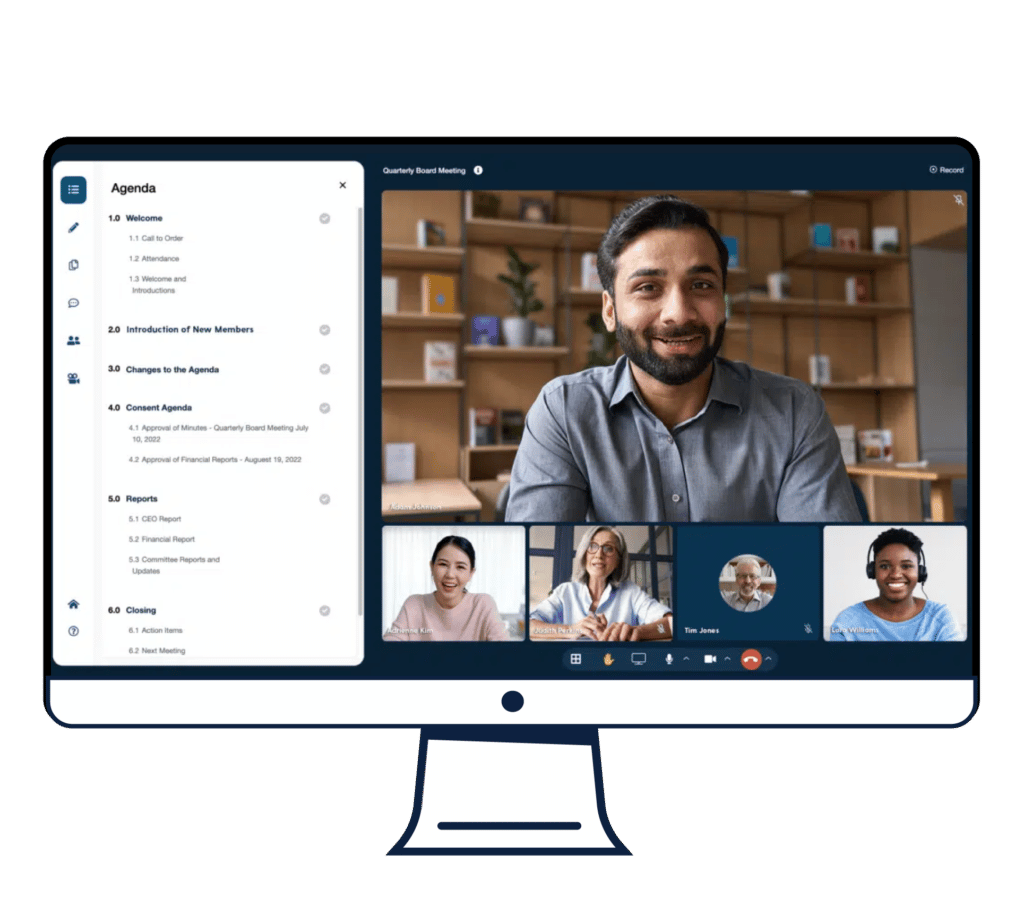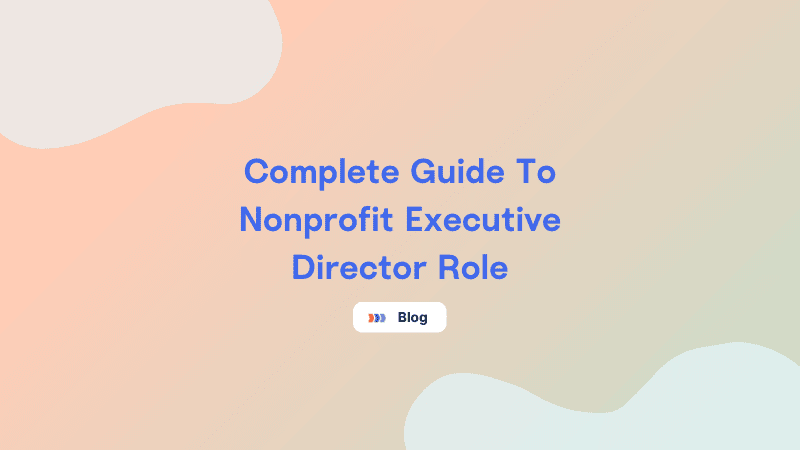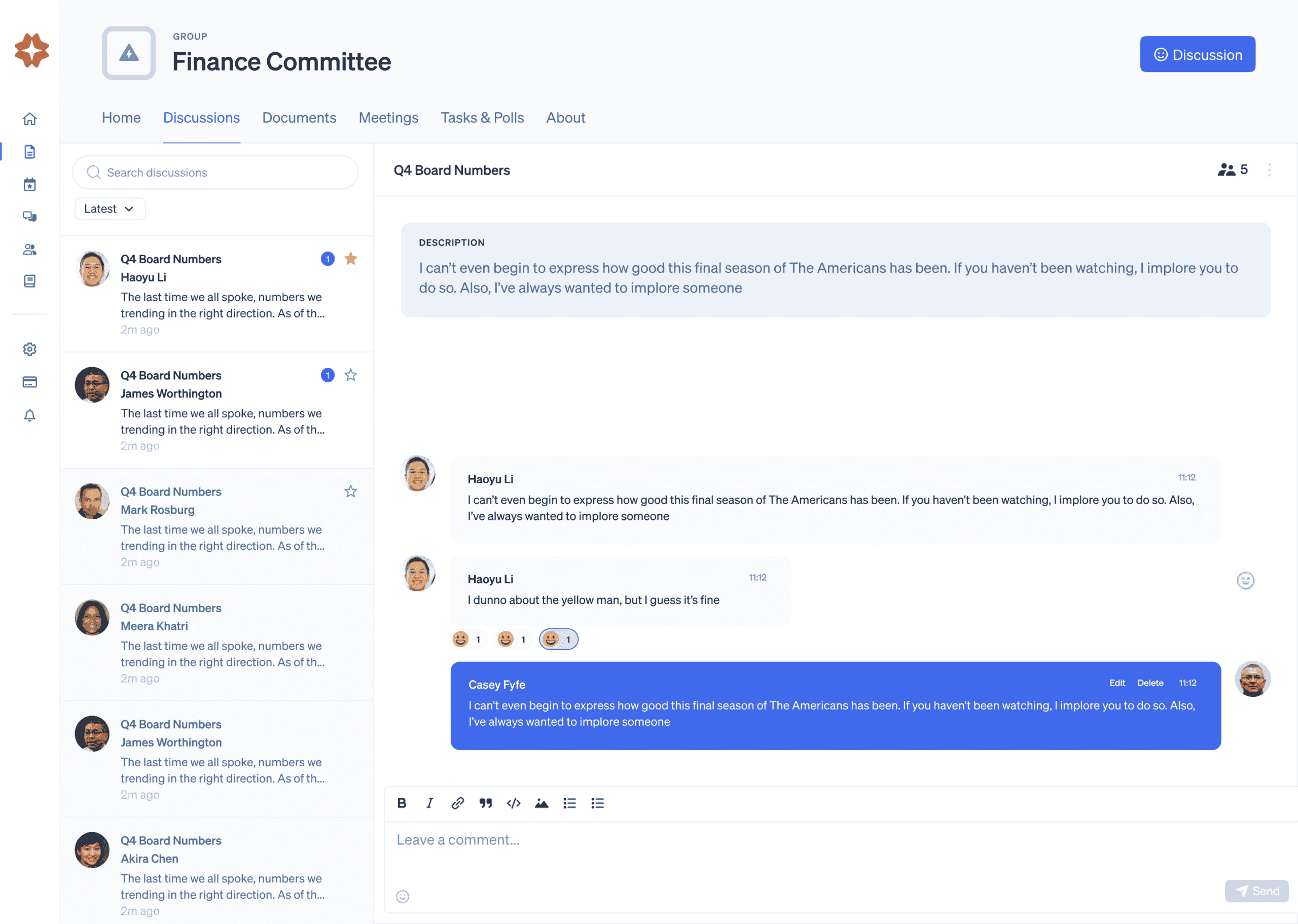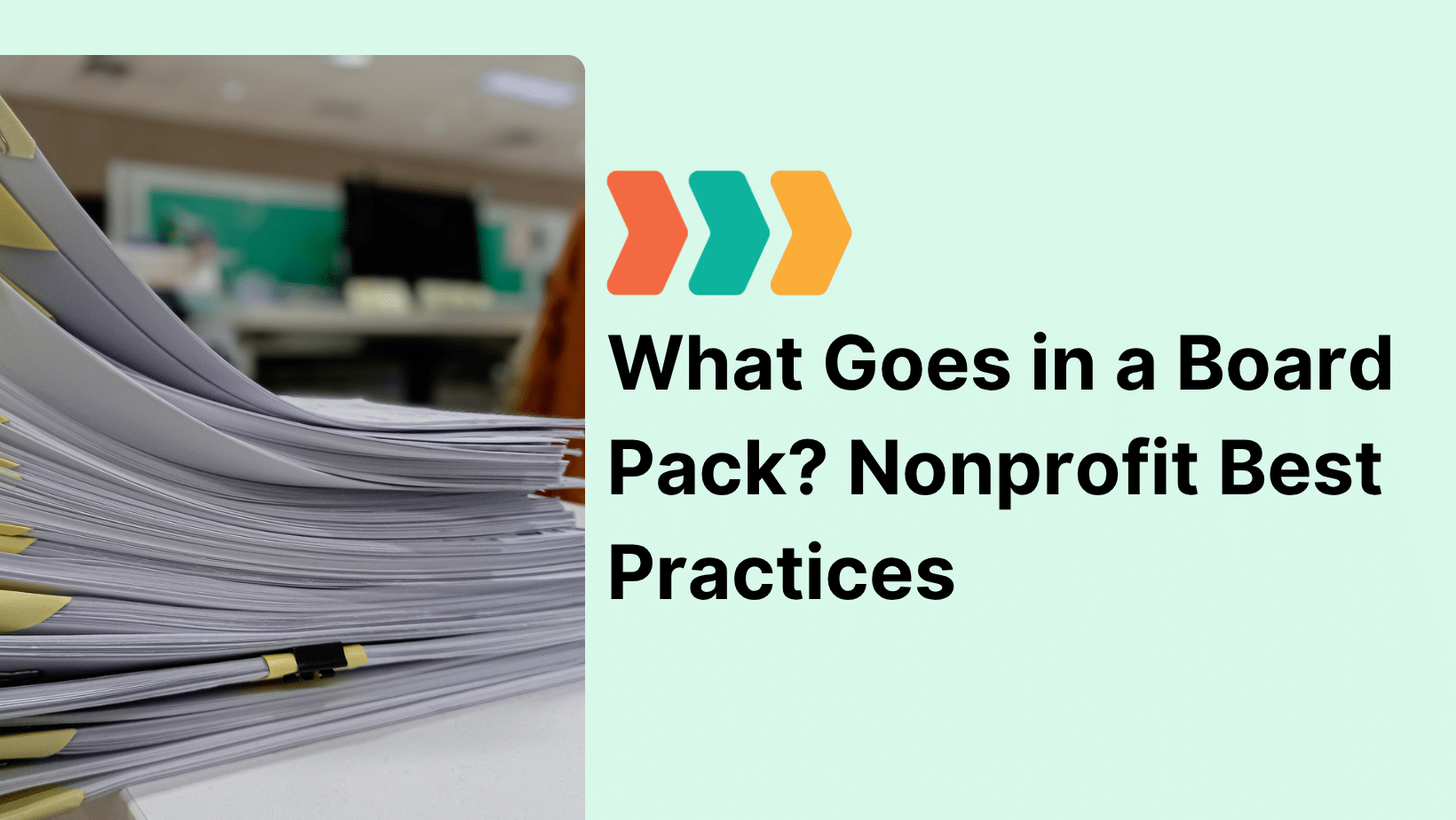A nonprofit executive director (ED) is equal parts strategist, community champion, and chief motivator. In 2025, the stakes are higher: donors demand transparency, boards want data-driven decisions, and staff expect inclusive leadership.
Our team of experts at Boardable has worked with thousands of nonprofit boards to pursue strategic growth. We’ve collaborated directly with numerous executive directors to help maximize impact and produce an outstanding experience for the boards they work closely with.
Whether you’re writing a job description, stepping into the role yourself, or supporting an existing ED, this updated guide outlines everything you need to know. We’ve created this guide to answer common questions and explore what it takes to succeed in this position. Here’s what we’ll cover:
- 8 Key Nonprofit Executive Director Responsibilities
- When Should a Nonprofit Hire an Executive Director?
- The Qualities of a Good Executive Director
- How to Maximize Impact as a Nonprofit Executive Director
A nonprofit’s executive director plays a crucial role in furthering the organization’s mission. Ready to learn more about the role and how to set this teammate up for success? Let’s dive in.
Solutions for Nonprofit Executive Directors
Boardable empowers executive leadership with one central place to share documents and plan meetings with your organization and board.

At-a-Glance: What Does a Nonprofit Executive Director Do?
Think of the executive director as the organization’s “chief impact officer”. They translate mission into measurable results by:
- Setting vision and strategy. Day-to-day planning rolls up to multi-year strategic goals and ultimately to mission fulfillment.
- Leading people and culture. From staff development to board engagement, the ED ensures every colleague, volunteer, and trustee rows in the same direction.
- Stewarding resources. Budget oversight, fundraising leadership, and grant compliance safeguard the organization’s financial health.
- Amplifying the mission publicly. Media interviews, conference keynotes, and community partnerships all flow through the ED’s office.
8 Key Nonprofit Executive Director Responsibilities
Whether you’re an aspiring director or tasked with crafting a solid nonprofit executive director job description, it’s critical to have a clear perception of what the role entails. Understanding the purpose of this position can shed light on how nonprofits function, helping to build out the role and maximize impact.
While each organization assigns different responsibilities to its executive director, there are quite a few consistencies across the entire nonprofit sector. The fundamental parts of the job are applicable to the vast majority of organizations, so let’s dive into several common responsibilities of executive directors.
1. Mission-Driven Leadership
The executive director often oversees the heads of each department in a nonprofit, including marketing, fundraising, program development, and HR management. Department heads look to the director for strategic guidance. For example, the executive director may lead the fundraising department in setting annual revenue goals, or they may help the program development managers set effective community service standards.
The smaller the organization is, the more directly involved it will be in each departmental function. For example, the smallest organizations may rely on the executive director to handle accounting duties, a portion of the fundraising duties, and executive-level duties.
With this direct influence, whoever fills the position should be able to clearly articulate the vision, mission, theory of change and strategic direction of the organization. That way, they can efficiently align the entire organization so that everyone is rowing in the same direction.
2. Board Development & Governance
An experienced board of directors provides strategic guidance based on valuable skills and contacts. However, board members aren’t responsible for making day-to-day operational decisions. That’s where the executive director comes in.
Essentially, the nonprofit executive director works to provide the board with the resources it needs to incite change and promote growth. Specifically, they play a role in selecting board members and acting as a liaison between the board and the staff. As one of the board’s primary resources, the executive director should be prepared to:
- Inform the board of staff changes, donor details, successful campaign details, and areas where the staff feels help is needed.
- Relay staff and volunteer engagement ideas, as well as concerns that need to be considered by the board, not the internal staff.
- Plan and prepare meeting structure and information for board meetings in coordination with the board chair.
- Supply the board with technology to streamline work and maximize impact.
What it all means is that the executive director must keep board members informed and work with them to come up with strategic solutions to any issues that arise. The joint approach to organizational growth will be invaluable as your nonprofit grows and inevitably encounters complex challenges.
3. Public Relations
Outside of normal business hours, nonprofit executive directors serve as the public face of the organization. This individual is the most visible and concrete embodiment of the organization and should take care to represent the nonprofit in a professional light.
Three duties tied to public relations efforts include:
- Attending and possibly hosting fundraising events.
- Showing up to new program kickoffs.
- Speaking with reporters, donors, and other community members.
The best nonprofit executive directors maintain strong relationships with peers, key stakeholders, the media, industry associations, and more. This ultimately helps the nonprofit put its best foot forward when launching outreach efforts or connecting with other organizations.
A spotless personal reputation is crucial because stakeholders tend to keep a close eye on the organization’s leaders. A scandal in the life of a nonprofit executive director can tarnish the organization’s reputation for years to come. In a way, executive directors should consider themselves “on duty” at all times to best represent their nonprofits.
4. Financial Management
The executive director is often responsible for fundraising and creating the conditions for financial success. This includes soliciting major gifts and working alongside the board and staff to develop actionable fundraising plans.
Further, this individual should also be able to demonstrate an ability to read and understand financial documents. This includes budgets, cash flow, income statements, balance statements, and so on. They should also understand the basics of 990 tax returns, audits, and compliance. They don’t necessarily have to be an expert, but a financially-competent executive director can brainstorm real growth strategies.
5. Relationship & Stakeholder Management
Beyond appearing at official events and speaking to community members, executive directors act as a liaison between their respective organizations and a large number of external stakeholders.
As we previously touched on, they should cultivate relationships with other nonprofit leaders and look for opportunities to partner with causes that align with theirs. Nonprofit executive directors also work with leaders in the business and government world to take advantage of applicable corporate social responsibility (CSR) initiatives. This empowers them to coordinate long-term strategic partnerships to fulfill the organization’s unmet needs.
6. Technology Enablement
The nonprofit executive director plays a role in the technological aspect of the organization’s operations as well. As your organization grows, proper policies and technology will be essential for future success.
For instance, as the board’s primary point of contact at the organization, the nonprofit executive director should supply them with the right tools for conducting collaborative meetings, communicating outside the boardroom, quickly executing decisions, and practicing effective governance overall.
Boardable offers everything a nonprofit board needs, from carrying out your meetings and delegating vital follow-up tasks to store your documents in a centralized and secure location.
By simplifying board members’ jobs with technology, the executive director can promote organizational efficiency and get back to what matters: inciting real change!
7. Organizational Development
It’s up to the executive director to help make powerful strides toward organizational development. This individual should set the nonprofit up for fulfilling its mission by advocating for the right systematic changes, whether those are related to policies, team behaviors, or programs.
In essence, stakeholders expect the executive director to set the strategy to achieve outcomes. This could mean ensuring the quality and effectiveness of programs, being on top of sector developments, and setting behavior expectations for internal personnel.
8. Compliance
The executive director should always make sure the organization is operating in compliance with all laws and regulations. While there are federal rules from the IRS and elsewhere, this also applies to all regulations in the states in which you’re operating and collecting donations. There may be local rules as well.
Beyond legal compliance, the organization should also adhere to the highest ethical standards possible. This can truly set the nonprofit on a different plane from similar organizations.
Pro tip: Centralizing board documents and discussions inside a platform like Boardable cuts prep time and keeps directors focused on strategy instead of logistics.
When Should a Nonprofit Hire an Executive Director?
Deciding when to bring on a nonprofit executive director (ED) can feel like threading a needle between budget realities and mission urgency. Some organizations install an ED from day one; others wait until momentum and complexity demand professional leadership. Below are the clearest signals that it’s time to recruit (or replace) and executive director, along with practical tips to manage the search successfully.
- Founders Hit Their Limit. In startup mode, passionate founders can wear every hat. But if the founding team lacks deep nonprofit governance, fundraising, or compliance experience, growth will eventually stall. An experienced ED translates vision into operational plans, cultivates donors, and elevates the organization’s credibility with external stakeholders.
- Revenue and Headcount Cross Key Thresholds. Operational complexity balloons once you surpass $1 million in annual revenue, oversee 10+ full-time staff, or launch programs in multiple locations. At this stage, informal leadership models break down. A seasoned ED brings the financial discipline, risk management, and multi-site coordination skills needed to sustain momentum.
- The Board Wants to Pivot From Tactics to Strategy. Board members are most valuable when they govern, not manage. If directors are bogged down in administrative tasks, like drafting agendas, corralling reports, troubleshooting budgets, it’s a sign to hire an ED who can assume day-to-day oversight and free to board to focus on policy, fundraising, and long-range planning.
- Communication Breakdowns Are Slowing Progress. Confusion about goals, roles, or daily operations signals a leadership gap. A strong communicator in the ED seat unifies staff, volunteers, and the board around shared objectives, sets clear KPIs, and keeps everyone moving in the same direction.
- Specialized Expertise is Missing. Rapid program growth often exposes gaps in finance, legal compliance, technology, or community partnerships. Recruiting an executive director with targeted credentials—MBA, MPA, CFRE, or CAE—can fill those skill shortages and safeguard the organization’s next phase.
Action Step: Owning the Hiring Process
Identify who will steer the search before you begin. Many nonprofits assign a dedicated board committee to craft the job description, screen candidates, and oversee interviews. Start by outlining core competencies, performance metrics, and a transparent reporting structure. That upfront clarity accelerates hiring and ensures your new executive director has the mandate and support to drive mission-aligned growth.
Essential Skills & QUalities of an Exceptional Nonprofit Executive Director
As you now fully understand, an effective executive director is an irreplaceable asset for organizational success. The board expects them to be practical and collaborative, serving as their connection to the rest of the organization. Staff members need an influential leader and a competent manager, while the community seeks someone who’s compelling and actively present.
The executive director must be—in a word—effective.
What does being “effective” look like in this role, though? To fulfill and exceed expectations, nonprofit executive directors need to possess the right skills. Let’s take a deep dive into three desirable qualities that the most effective executive directors possess:
- Outstanding Communicator. Above all else, nonprofit executive directors are communicators. They work with a wide range of individuals, all with different personality quirks. They speak on behalf of the organization in public settings, maintain an open line of contact with the board, and discuss initiatives with staff members and key stakeholders. They should be able to actively listen, know when and how to speak up on behalf of the organization, and constantly be ready with facts.
- Data-Savvy Strategist. Modern nonprofits swim in dashboards, KPIs, and impact metrics. An effective ED filters that information into actionable insights, adjusting course quickly as conditions change. They pair intuition with evidence, ensuring decisions are rooted in both real-world data and mission values, whether that’s reallocating program budgets or tweaking fundraising tactics.
- Inclusive & Culturally Aligned Leader. Psychological safety and a sense of belonging drive talent retention and innovation. Successful executive directors model equitable practices, champion diverse perspectives, and mesh naturally with the organization’s culture. When a leader authentically reflects core values, staff buy-in soars, and external stakeholders gain confidence in the nonprofit’s integrity.
- Financially Fluent Operator. From 990s and audits to multi-year cash-flow projections, fiscal stewardship is non-negotiable. High-caliber EDs can both interpret and articulate the numbers, ensuring the board understands risk, compliance obligations, and investment opportunities. This fluency protects organizational health and positions the nonprofit for sustainable growth.
- Mission-Driven Change Champion. Technology upgrades, new funding models, and shifting regulations are constants in today’s sector. Exceptional executive directors guide teams through transformation without mission drift. They balance innovation with stability, shepherding pilots, partnerships, or policy pivots that expand impact while safeguarding core programs.
- Relevant Background & Continuous Learning. Deep nonprofit experience or a proven willingness to learn quickly enables an ED to anticipate sector trends, understand donor motivations, and navigate compliance nuances. Leaders with MBAs, MPAs, CFREs, CAEs, or comparable credentials often arrive with an analytical toolkit that accelerates progress. But just as valuable is a growth mindset: the curiosity to seek mentorship, training, and feedback as the organization evolves.
Bottom line: An executive director who communicates persuasively, steers strategy with data, nurtures an inclusive culture, masters the finances, drives intentional change, and continually sharpens their expertise becomes an irreplaceable asset, amplifying mission impact and elevating the entire organization.
Maximizing Impact: Practical Tips for Today’s Nonprofit Executive Directors
With the power this position holds, there’s no room for mediocrity. Those initial skills will serve as a solid foundation when getting started, but true changemakers will go further by taking the necessary steps to grow as leaders and leave a positive legacy on the organization.
Whether you’re an aspiring executive director or someone who wants to improve your executive director’s experience, here are some tips for maximizing impact in the role:
- Invest in Board Readiness. Start every board member off on the right foot with bite-sized onboarding modules, peer mentoring, and clearly written committee charters. When board members know the playbook and their own roles, they can contribute meaningfully from the very first meeting, freeing you to focus on strategy rather than orientation.
- Leverage Technology. Modern board portals automate the headaches: agendas build themselves, e-signatures happen in seconds, and post-meeting surveys arrive before board members even close their laptops. By streamlining these administrative tasks, you can reclaim hours for program innovation and stakeholder cultivation.
- Prioritize Talent Wellness. Burned-out teams can’t drive mission impact. Embed flexible schedules, wellness stipends, and dedicated professional development funds into the annual budget. A culture that values balance and growth reduces turnover, boosts creativity, and signals to funders that you steward human capital as carefully as financial capital.
- Tell Data-Rich Stories. Pair outcome metrics with compelling human narratives in donor updates, grant reports, and social campaigns. Numbers validate credibility; stories spark emotion. Together, they deepen engagement, inspire larger gifts, and position your organization as a transparent, results-oriented leader.
- Build Adaptive Revenue Streams. Diversify beyond traditional fundraising by layering in fee-for-service offerings, social-enterprise ventures, and recurring micro-donations. This blend cushions the organization against economic turbulence and provides the flexible capital needed to seize unexpected opportunities.
Even the best nonprofit executive directors aren’t flawless. As humans, these individuals make mistakes but understand the value of turning those slip-ups into growth opportunities. Whether freshly appointed or seasoned veterans, an executive director reflects on their strengths and their shortcomings. This empowers them to push themselves to become better with every opportunity. Implementing even one of these tactics can move the needle; tackling all five sets the stage for exponential gains in sustainability, credibility, and mission impact.
Conclusion
Executive directors are the keystone for the lasting success of any nonprofit. From internal development to public relations, this position holds an immense amount of power and responsibility. Taking the time to fully understand the role’s correlating duties, necessary skills, and best practices for maximizing impact allows nonprofit leaders to make the most of the position.
Keep in mind that the exact role of the nonprofit executive director varies from organization to organization, but there are universal duties and expectations that all of these individuals should fulfill.
No matter the cause, the nonprofit executive director should be an outstanding leader who constantly pursues growth and works with the staff, board, and key stakeholders to achieve positive outcomes for the organization. Someone who doesn’t cower in the face of adversity and who perceives challenges as growth opportunities can lead your nonprofit toward a sustainable future.
Ready to empower your executive director and your board to do their best work? Request a demo of Boardable and see firsthand how streamlined meetings and centralized documents translate to greater mission impact.








